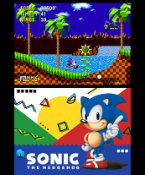
It’s fascinating to go back to the original Sonic the Hedgehog after so many years and so many new entries in the series. These days, everyone wants to convince you that Sonic is a game all about speed. Without it, it’s simply not the same – not like the original titles on the Genesis. What the original game has reminded me of is that Sonic is a platformer first and foremost and a game about speed second. Very rarely does Sonic hit breakneck speeds in his debut; more often than not he’s taking calculated jumps in a sidescroller that’s merely more mobile than the one that features his Italian plumber counterpart.

Just to get it out of the way, of all the recent Sega 3D Classics to release, Sonic has the least impressive 3D visuals. The various layers that comprise the visuals of each level have been separated out into different 3D fields, but it’s very subtle effect that doesn’t do much to make the game look more impressive. Of course, it’s still a timeless classic and the colorful worlds are just as great as ever to look at, just as the music is as catchy and memorable as it was in the ‘90s.
Other upgrades to the core game include a level select mode, save state ability, and the inclusion of the spin dash, which truthfully serves little purpose. It’s nice to have feature parity across all of the Sonic games by including the move, but because the levels weren’t built with the move in mind it is very rarely useful.

Like the other 3D Classics, these standard features, particularly the save state, make the game much more approachable. Ensuring that you obtain all of the Chaos Emeralds is much less of a chore when you can restart the special levels or even move back to a save state before you hit an unforeseen impediment and lose your whole stash of rings before the exit.
Frankly, I’m still stunned at how not fast the original Sonic the Hedgehog is. I’ve played the game countless times as a kid and many other times as an adult and I seem to recall it moving so much faster than it really does. More often than not, Sonic is in motion, but many of the jumps that need to be made, need to be made with a degree of precision. Whether it’s landing on a moving platform or avoiding apparent impediments, Sonic needs to move with regard. Don’t get me wrong, there are opportunities to book it through the levels, especially when you get the invincibility power-up, but speed is certainly not the core focus of the experience.

While I enjoyed 3D Sonic the Hedgehog, its foundation is certainly not the best in the series and its 16-bit successors outpace it in nearly all regards. Much like going back to the original Super Mario Bros, you can recognize how the game created a legacy, but it’s hardly the definitive experience of the series’ glory days.
If you’re a Sega enthusiast, or want to have a portable copy of Sonic the Hedgehog, it’s hard to go wrong with this 3D Classic. The game is only improved in this 3D rendition and while it doesn’t have the glitz, glam, or complexity of its sequels; it’s still an interesting experience nonetheless. Just remember folks, Sonic wasn’t always about speed.
Review Policy
In our reviews, we'll try not to bore you with minutiae of a game. Instead,
we'll outline what makes the game good or bad, and focus on telling you whether
or not it is worth your time as opposed to what button makes you jump.
We use a five-star rating system with intervals of .5. Below is an outline of
what each score generally means:

All games that receive this score are
standout games in their genre. All players should seek a way to play this game.
While the score doesn't equate to perfection, it's the best any game could conceivably do.

These are above-average games that most players should consider purchasing. Nearly
everyone will enjoy the game and given the proper audience, some may even love these
games.

This is our middle-of-the-road ranking. Titles that receive three stars may not make
a strong impression on the reviewer in either direction. These games may have some
faults and some strong points but they average out to be a modest title that is at
least worthy of rental for most.

Games that are awarded two stars are below average titles. Good ideas may be present,
but execution is poor and many issues hinder the experience.

Though functional, a game that receives this score has major issues. There are little
to no redeeming qualities and should be avoided by nearly all players.

A game that gets this score is fundamentally broken and should be avoided by everyone.















Comments